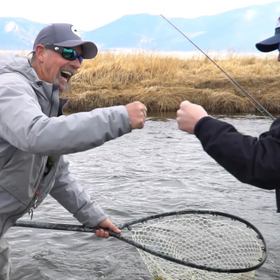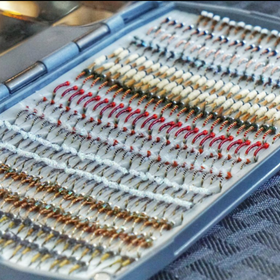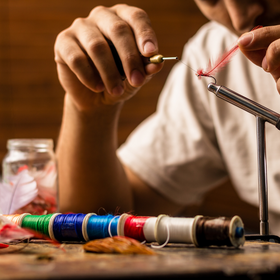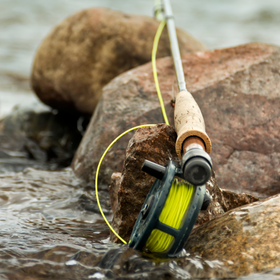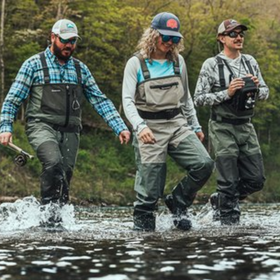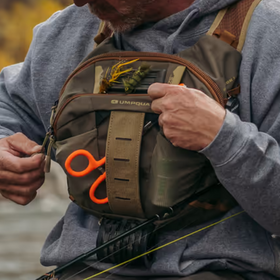Fall Is For Streamers
By Richard Magill
I recently ventured out to the famed Dream Stream on a rainy, overcast day. Air temp was hovering around 42 degrees Fahrenheit with zero wind. The rain was relentless, saturating the ground and washing mud into the water.
I brought both a 6-weight and a 7-weight rod with me so I would have all bases covered. I ended up choosing the six because again there was zero wind. The rod was a 690-4 R8, the reel was a Sage Arbor XL 4/5/6 with the RIO Predator line in the Float/Sink 5/Sink 7. The line features a 36’ head with all the mass up front making this line perfect choice for throwing larger streamers or any wind-resistant bug.
The first fly I went with was #6 white Lightning Leach fished on a slow retrieve. I fished for about 15 minutes without a grab, so I decided to change up my cadence. I sped up the action and implemented a jerk-strip motion. If you’re not familiar, it is a retrieve made popular by Kelly Galloup, the famed streamer guru up in Montana. You basically pump the rod tip to impart action or swim the fly, then strip in the excess slack. Doing so can elicit exciting follows with savage eats. The strategy paid off after I managed to land my first fish of the day. Then on my next cast a massive cut bow smoked my fly right before I pulled it from the water. I continued with this fly and retrieved for another hour, managing a few more fish before the action started slowing.
This was a great opportunity to eat a snack, hydrate back at the car, and tie on a #1/0 black Meat Whistle. The brown trout certainly responded with lights-out action. It seemed as if I got a follow or eat every cast. Unfortunately, I ended up snagging on a log and losing the only black Meat Whistle in my possession. The next fly on the roster was an olive Complex Twist Bugger. This is when fishing slowed down and became very challenging. I’m not sure if it was the time of day or the increase in precipitation. Anyhow, I ended up calling it shortly after my last fish – a small but tenacious brown.
As fall progresses the streamer bite is only going to get better with large predatory trout putting on the proverbial "feed bag" before the harsh months of winter settle in. If you’ve ever wanted to go a few rounds with trophy trout, this is the time of year to go searching. Streamers will certainly give you your best opportunity to land that fish of a lifetime.
If you are somewhat streamer curious and looking to try it for the first time, a dedicated rod specifically for throwing big flies is a great place to start. 6-weights are good rods for targeting trout with small to medium sized flies, while 7-weights are the preferred size for launching large, wind-resistant flies (think bulky dear hair heads). Rod length is also another interesting variable. Generally, shorter rods are going to be more accurate, while longer rods will allow the angler to cast a bit further. The Payload series of rods by Sage are a bit shorter than the traditional 9-footers. The 6-weight comes in at 8’ 9” providing superior accuracy when tossing the big stuff. Paired with the RIO Predator line and the Arbor XL for taming huge salmonids, the Sage Payload is a fantastic option for setting up a streamer-centric rod.
The 7-weight I’ve been throwing all summer is the new R8 from Sage. Long story short, it’s the best 7-weight I’ve ever had the pleasure of fishing. It's incredibly accurate, has a super light swing weight and all the fish fighting power a person could possibly want. It also doubles as the best carp rod I have yet to come across. Bonus!!
Other great options for rods include but are not limited to the Orvis Helios 3D 907-4, the Scott Centric 9’ 7wt, the Sage Maverick 790-4, the Orvis Recon 906-4, and the Sage Igniter in both the 6wt and 7wt, the Scott Wave in 9’ 7wt
When choosing a reel for your streamer setup it is important to think about all the applications you want your reel for. If you’re only going to fish in a freshwater environment, then a fully sealed drag wouldn’t necessarily be a requirement. With that in mind, having a fully sealed drag would effectively turn your 7wt streamer rod into an excellent light saltwater rod. Adding a level of versatility ensures an angler can get the absolute maximum usage out of their gear.
Line selection is perhaps the most critical variable in the equation. Some anglers only use floating lines regardless of application. While a floating line will work in a pinch, it is my opinion that either a full sinking line or a line with a sinking tip is superior for swimming bait fish patterns. Using an aggressive full sinking line also allows a person to work their fly at a breakneck pace without lifting the streamer out of the strike zone. Sinking lines are also the line of choice during cold months as the fish will be holding in deeper slower water.
Scientific Anglers has a plethora of different sinking densities making it easy to find the perfect line for your specific fishing demands. I personally enjoy fishing the Sonar Intermediate/sink 3/sink 5 line from SA. I also like fishing the Predator series of lines by RIO when I’m throwing larger bugs.

Tippet selection is very straightforward. 0X Fluorocarbon. Don’t overcomplicate things. The trout didn’t pass up your streamer because it saw your tippet and got scared. That’s ludicrous. The rig I use is 8” of 20 lb saltwater fluorocarbon tied to a 30lb barrel swivel. From that swivel I tie 28” of 0x fluorocarbon. The use of a butt section attached to your fly line is going to protect your welded loop and aid in turning over flies. The swivel will help alleviate line twist from retrieving your streamers.
Fluorocarbon is important because it is abrasion resistant and has little-to-zero stretch. The zero stretch is handy when strip setting your meat into the jaw of a big old trout. Abrasion resistance comes into play when you inevitably throw a meat whistle into heavy cover and drag your leader over rocks and timber just before a 26” donkey smokes your fly. Nylon would fray creating weak points that would ultimately break under duress.
When an angler is choosing streamers, they can approach it from two different angles. You can try and "match the hatch," i.e., throw streamers that imitate the baitfish, leaches, or crayfish living in the water they are fishing. Or you can throw attractor patterns to elicit fierce strikes. Attractor patterns don’t necessarily have to look like something you see in nature. It just needs to anger or startle the fish causing it to strike. At the end of the day, it doesn’t matter if the fish tried to predate your fly or simply tried to kill it.
That’s streamer fishing in a nutshell. It’s not too complicated and the best part is the ability to catch fish all over the planet with this technique. If a species of fish predates other fish, then streamers will work to catch them.
If you have any questions about rigging or you’re simply looking for some spots to toss streamers feel free to swing by the shop. We can certainly help get you dialed before you hit the water.


